Fall has definitely shown it's face. We've been dipping into the upper 30's at night. The days, however, are still climbing into the 80's. This makes it tough to manage the hive. I'm tempted to shut up the bottom board to keep them warm at night, but I don't want to them to over heat in the day time. So far I've let them tough it out, but I'm anticipating closing them up soon.
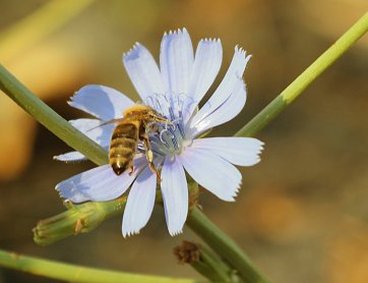 The bees are busy, though. They have been working some wild flowers, such as this chicory. The small blue flowers show up in the mornings and the bees gather a white pollen from them. By noon, the flowers are completely gone, having shriveled up in the mid-day heat.
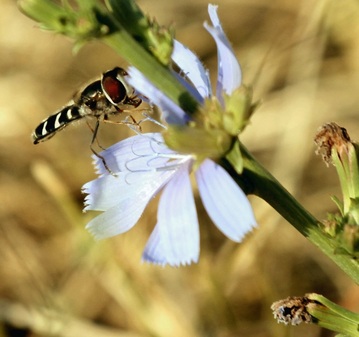 The bees aren't alone out there. These little guys are common too. They are flies (syrphid flies) and they mimic the coloration of bees. You can typically find them hovering, seemingly motionless, over the ground.
 The sunflowers are finally out too. While the bees ignored them initially, they are on them now, perhaps because other things are sparse.
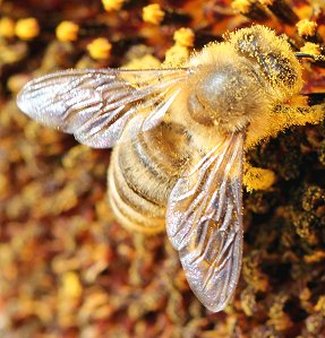 The bees get covered in pollen when they walk around on the flower heads (actually a large collection of numerous small flowers).
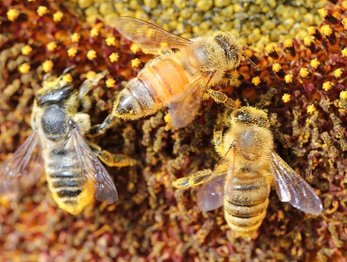 Here too, they have company. The bee on the left is a leaf cutter bee. These guys are the ones that leave little circles cut out of your rose leaves. They use the material for nesting. They are also raised commercially as pollinators. Unlike honey bees (on the right), leaf cutter bees collect their pollen on hairs under their bellies.
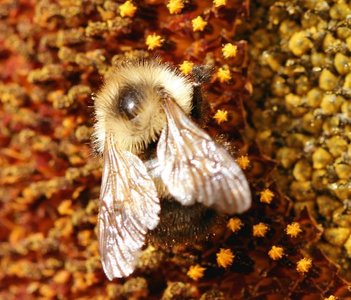 Of course, the always present bumble bees are there too.
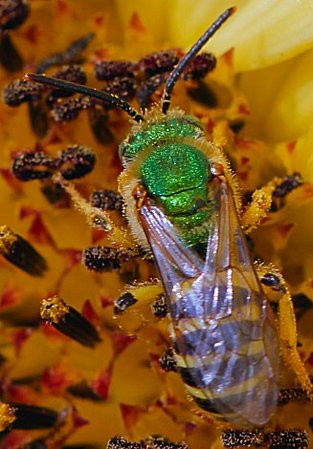 And these bright colored bees. This is a halictid bee, which can be iridescent like this (usually green). Many people refer to them as flying jewels.
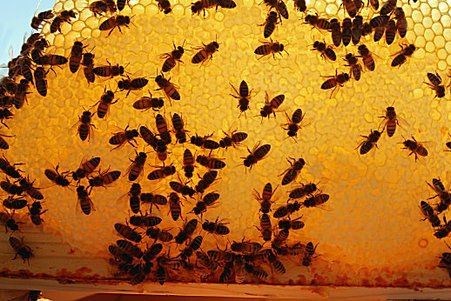 So, while I'm busy getting ready for winter, the girls are at it too. They have a bit of honey here on this comb, under the capped cells.
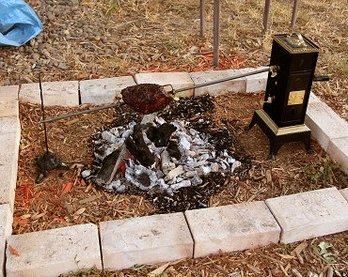 Well, there is some R&R too :-) I picked up a "must have" toy called a clock jack. It is essentially a wind up rotisserie. A bit of fun over a make-shift fire pit and a few beers. Cooking a pork roast with blackberry glaze here. Speaking of cooking, we have a new blog on that topic up in the menu above. Drop by and check it out!
The sun is just poking up over the back hill. Half asleep, I walk out to survey the yard before going to work. An unexpected shiver runs down my spine. It's cold! After weeks of uninterrupted dry heat, Autumn has briefly brushed her cool hand across the Palouse. It's a reminder of things to come. The signs have been there ... the lush green fields of grass and wheat have turned a bright golden hue, the leaves on the trees are drying from the lack of water, and a few tomatoes in the garden have dared to start turning yellow and orange. The bees are starting up early, as usual, pushing these last days of sun to prepare for winter. A quick inspection last weekend found a good number of bees, honey, brood, and a big fat golden queen. So, I've left them to do their thing until I interrupt them again later in the fall to settle them in for the long haul through winter.
This seasonal changing of the guard was violently announced a few nights earlier when a flurry of lightning storms crashed through during the night, ending the slumbering doldrums of summer heat. It was, perhaps, a fitting event. Today, Kara and Trevor leave us for opportunities in Montana. We've had a wonderful summer with them. The parting is bittersweet. We are sad to let them go, but enthralled with the excitement in their eyes, the places and things they will see and do, and thankful for the memories this brief time we have spent together has brought us. It was, at times, hectic, dogs always underneath, each of us bumping into one another with the bustle of living together as family. They too, I'm sure had to endure our "set" ways and my occasional grumpiness. But I hope the memories will be of the good times, of the salmon and pasta, the fresh berries, the laughter, the family and friends. It is a good reminder of what I'm sure Jess is tired of hearing me tell her ... "Enjoy where you are now. These will be the good ol' times you will be laughing about later." I know I will be fondly remembering this summer for a long time.
Farewell and Godspeed to both of you. We'll miss you.
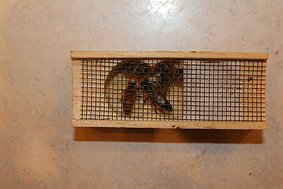 So, what’s been up in August? Well, I last left you with, “we need to wait”. Well, I’ve been waiting, and watching from a distance. No big inspections, as I didn’t want to disturb things too much. After adding the queen, things seemed pretty much the same, which to be honest, was expected for a while.
The news, I think, is good, however. Lately I’ve noticed more bees in the hive (I have been peeking in the window!). And from the outside, there is evidence of rejuvenation hidden inside. There has been a good amount of pollen moving in. This is a good sign as pollen is fed to developing larvae. Although I haven’t been inside for a while, the seemingly more numerous residents and the pollen going in tells me I probably have a queen. I also have not seen many drones. This is important because if the hive were queenless too long, a worker bee might develop egg laying capabilities. The eggs she would lay would be unfertilized, however, and the results would be a lot of drones. So, all together, things are looking up.
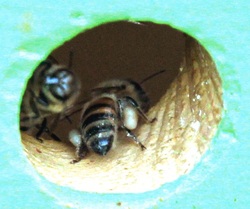 As for the pollen, I’m not sure what they are finding. There was a lot of this, a gray colored pollen, going in, but I have no idea what it is. Some bright orange pollen too.
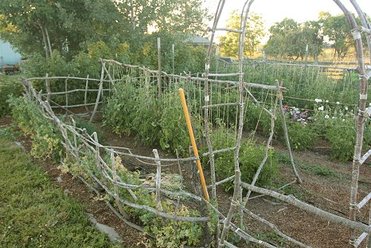 On other fronts, some have asked about the garden and the infamous tomato trellises. I’m happy to report that the garden is doing spectacular this year and the tomatoes are outdoing themselves. I am using an A-frame type design with pole stretched between them. There are strings running up and down between the top pole and a bottom one, to which the tomatoes are intertwined. Lots of green tomatoes, so, if the weather holds, we’ll see some good eats soon. The peas are shot (2 gallon bags frozen for winter), and many carrots and potatoes waiting in the ground. Some of the flowers finally turned on, although the bees have completely ignored them.
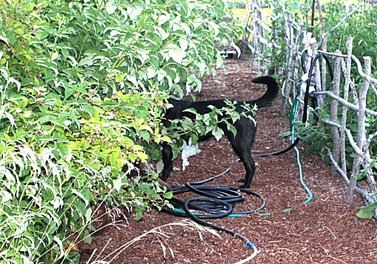 Oh, and the raspberries have been great, although a certain Wendy dog likes to steal them. She even taught Griz and Meadow the art of berry picking. Seriously, they just stand out there stealing berries!
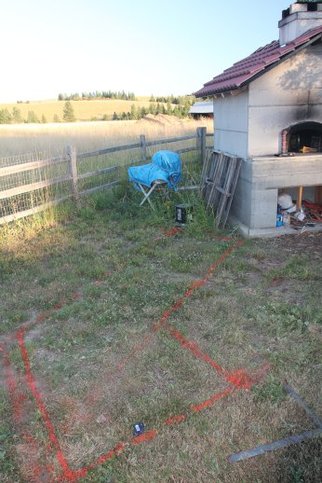 I also finally got started on the extension to the wood oven, a counter bar for enjoying the back with a nice seat and view. A lot of work! 3 yards of dirt dug out by hand (did I mention it hasn’t rained in a month and a half. We are finally catching up on the heat that the rest of you have been enduring!). The hole was filled in with 2 tons of concrete and gravel. No, seriously, two tons of each! Fortunately, Beth, Kara and Trevor helped with all that.
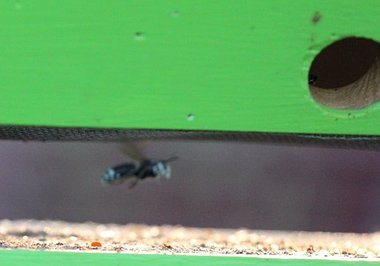 And then …, there these! This is a bald faced hornet. They are big, black hornets (about twice the size of a bee) with greenish blue tails and faces. There seem to be a lot of them around this year. We have had them before when they stripped the bark off a birch tree in front, but this year, they abound. I caught this one searching around the hive, probably looking to raid the honey stores or grab a victim for its nest and larvae. This time, it couldn’t find the entrance.
This evening, however, I had the window on the hive open, just quickly checking things out. I heard the low buzzing that the hornets make behind me, and turned to see one cruising in, over to the hive. I didn’t think much of it, but the next thing I know, it pops into the entrance and begins to check around inside the hive. The response didn’t take long. Several bees immediately jumped it, and a battle began. The hornet had the advantage of size and a very powerful sting (they are extremely painful and can sting multiple times). The bees, however, had the advantage of home turf and large numbers. Their response, though, was not what you would expect. Unlike some Hollywood script, they did not try to sting it to death. Rather they quickly surrounded it, hundreds of bees, and began to smother it. They hung in a very tight clump from the top of the hive for 20-30 minutes, covering the hapless hornet in a layer of bees 4-5 deep. Their aim was probably to cook the attacker to death. Insects are temperature sensitive and eventually they simply got it so hot that it died. It was a smart defense as they had little hope of over powering their foe or out stinging it. I saw only one defender drop to the bottom of the hive dead, so the losses were minimal. So, invaders beware!
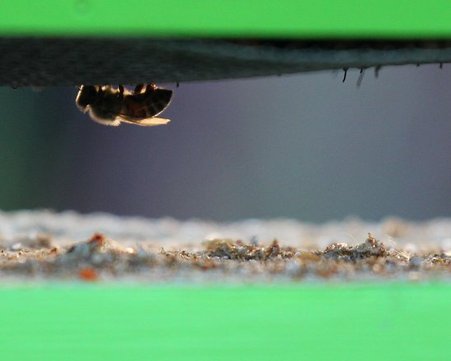 I guess that about wraps up August for now. Positive things that are a good portend for the fall and winter to come.

An inevitable and necessary activity which enables "Play" (see below). Also intimately related to "Time" (see below), and can preclude other activities such as bee keeping, blogging, hammock testing, and beer/wine tasting. May also extensively involve yard maintenance activities.
Use: "Bill was too busy with work to keep up with the bee blog."

The paradoxical mate to "Work" (see above). While considered by most to be necessary for relief from work, it is almost always dependent on "Work" for existence. The balance between "Work" and "Play" can be notoriously difficult in Northern climates where one year of activities are carried out in three or fewer months when temperatures allow. Like "Work", "Play" is intimately related to "Time" (see below).
Use: "Bill was too busy at play to keep up with the bee blog."

A mythical concept. Can be consumed in large quantities by both "Work" and "Play". This relationship can be difficult to quantify, however, as "Time" will always be too short during "Play" and too long when at "Work". Through an unknown quantum mechanism, "Time" is also known to accelerate as one ages.
Use: "Bill was too busy with both work and play. He ran out of time to keep up with the bee blog."

Quality required of bee blog readers.
Use: "Please be patient with Bill as he consumes too much time at work and play to keep up with the bee blog."

Oft repeated tidbits regarding bee keeping which are well known and masquerade as fact. They typically appear in the form of books, magazines, on-line forums and 'old timers' advice. Caution should be exercised when using "Common Wisdom" as they represent only one of several possible outcomes from a bee keeping event which will almost certainly turn out differently than as advertised in the tidbit.
Use: "Common wisdom - A swarm will settle out on a tree where it can be gathered to start a new hive; Reality - The swarm leaves the tree and balls up in the grass directly under the original hive."
Well, it has been a while! Ok, so here's the low down... After all the swarm business, the Blue hive sat empty, the Green hive was buzzing with activity. I was waiting for the Greens to produce a new queen. After a while I checked. The queen cell was empty and I could not see one in the hive. I decided to let them try again. One hot evening, while Beth and I were in the garden doing "Work", we noticed bees clumping outside the hive. This is not unusual in the heat (called bearding) when they are trying to keep things cooler inside. I peeked inside through the window. "Hmmm, sure are a lot of bees in there!" I expanded the number of bars they had available, just to give them a bit more room.
The next evening, after "Work", I went out and looked in the hive window again. A lot less bees. Like, one third to a half as many! They had swarmed again! A quick tour around the property revealed no AWOL clumps hanging around. So, they were gone ... again. The remaining bees were busy, as usual, but the hive seemed so vacant after the night before. I'm now suspecting that when the Blue hive failed to stay the last time, they had actually returned to the original Green hive and were waiting out another new queen hatching. I inspected and did find the queen cell and decided to give it some time, i.e. we went away for some "Play" and I couldn't do anything anyway. When I returned, I inspected again. I could not find a queen or any eggs or larvae, although the queen cell was empty. They were apparently queenless. So I ordered a new queen. I picked her up in Spokane last night and put her in the hive this morning (in a cage). I will release her tomorrow. They may or may not accept her. Requeening can be tricky (so the "Common Wisdom" says). Nothing to lose now anyway. There are several combs with honey (very heavy), so, if they don't take to her, I will wait it out to spring time, see if they survive on their honey, and then combine them with a new package when I can. As you have seen before, now we just wait.
I guess I'll finish up now as the hammock is calling me to "Play" and the garden is screaming at me to "Work" ........."Time", "Time", "Time"! I seem to have lost it. Have you seen it anywhere?
It's been a long cool spring and early summer, but in spite of that, the numerous tomatoes I planted are now poking out of their plastic covers yearning for more space and freedom. On Saturday, Beth was out of town and Kara and Trevor were out on the perennial hunt for salmon, so it seemed like a good time to ponder the plight of the tomatoes and possible trellis solutions for my potential bounty. At noon, I settled under the trees by the oven with a light G&T, looking over the garden and considered the possibilities. I was tired from too little sleep the night before and was half heartedly considering the problem. Earlier, I cut some branches and made a few trial A frame designs. Workable, but a lot of branches to cut for all those tomatoes. Another cool sip of G&T and more pondering. It is getting warmer and I'm feeling lazy in the early afternoon heat. My eyes are getting heavier and soon I'm slumbering, vaguely listening to the birds chatter and the bees gently humming in the background ……………. zzzzzzzzzzz …………… zzzzzzzzzzzzzzzz ……….. buuzzzzzzz ……….. Buzzzzzzzz ……….. BUZZZZZZZZZZZZZZZZZZ!!!!!!!
I open my eyes, startled awake. What the He………………! A storm is whipping up over the garden. The airspace over the hive is a cloud of whirling bees. The noise is deafening, even from 40 feet away. The cloud is spreading out, and slowly, it starts to sink into my sleepy head…….. They’re swarming! Damn! The plan was to check out things in the hive tomorrow, just in case they were up to anything. Nothing has been obvious through the window, but I had a suspicion it might be a good idea to take a peek inside. Too late now.
View full screen in YouTube with the sound up for the full effect ;-) YouTube Vid
I get up from my stupor, still trying to take it all in. I hurry, crouching down, around to the back of the garden trying to convince myself this isn’t really happening. Maybe my imagination is getting the better of me. The reality, however, is becoming clearer. As I get closer, the bees are zipping all around me madly. I can see the hive entrance. It reminds me of a teenage horror movie. Bees are streaming out the entrance holes, marching in line up the face of the hive where they take flight and join in a swirling tight mass over the hive, like a bee tornado. "Goats", I chant to myself. "I could have kept goats! They don't do this!"
I frantically try to recall everything I’ve read about swarming. There must be a new queen and the old one is splitting off with a good portion of her offspring. A box! I need a swarm box. It’s coming back now, all the DVD’s, and books, and internet browsing. I’d thought about making a swarm box earlier, but it didn’t seem like a pressing thing to do. I mentally inventory where all the materials might be. The box will be necessary to capture the swarm and possibly start another hive.
The cloud is slowly drifting now. I scan the trees adjacent to the bee yard. There! They are starting to gather on one of the ash trees. The limbs that they cling to are bowing down under the weight. I somehow think to make a call to a beekeeping friend for some advice. I hear laughter from the other end. “Welcome to beekeeping”, he chuckles. “Yeah, thanks!” I reply. “Let them settle and cluster tightly. They will probably hang around for a bit and you can get them later. Evening is a better time to try to capture them.” I quiz him on several plans of action running through my head. He patiently replies. I finally let him go and it occurs to me I should try to capture this on the camera. The activity is still going strong. The bees are now all around me, bumping into me, giving me the surround sound buzzing experience. “Stay calm. Bees are best handled when you are calm”, I tell myself over and over as I hurry into the house. The house is strangely quiet. Fortunately, all the dogs are deep into their afternoon naps and are oblivious to the ruckus outside. I mentally note that my tiredness is gone, the G&T forgotten, adrenalin pumping away. The bees were not aggressive, I think to myself. Although they were flying everywhere and the noise was incredibly loud, I felt no immediate danger. They were totally focused on one thing only. It was, to say the least, very surreal.
I grab the camera, and come back out. The cluster on the tree is growing. I shoot some quick shots, try some video, anything that can get the experience, although I know it will be hard to convey later.
Satisfied that they are gathering on the ash tree, I go back into the house and hunt down a box, tape and screening. The swarm box is a temporary home where you try to contain a clustered swarm of bees. They will settle out around the queen and, as long as you capture her, they will stay put. The box itself needs vents, covered with screen, and a small entrance. It will allow me to move them from where they settle out to the second hive. Thankfully, I built a second hive and had even prepped it the day before, “just in case”!!
I glance out the kitchen window at the ash tree. The limb is really bowed down now. I hurriedly cut some holes in the box, fix the screening, and turn it over, checking my work. I look out the window again. ……… Oh no! They’re gone! Just like that, they have disappeared! The limb is as always, blowing freely in the breeze. I rush back out and begin searching. I can still hear them. I walk further back into the yard. There, in the bee yard. They went back to the hive and are now coating the whole outside and hive legs. Double damn! They aren’t supposed to do that! Didn’t these guys see the DVD!? At a loss and, now without a plan again, I stroll over to the back of the bee yard and squat down to watch them. They are marching along the legs, some on top of the hive. I watch and wait. They seem to be dissipating. After a long while, it quiets down again. The swarm has seemingly disappeared. “Maybe they went back inside”, I hope to myself. While unusual, it can happen. I walk closer to the hive. Foragers hover busily in front like usual. Something catches my eye under the hive …. Uhhhg! A big puddle of bees is nestled in the grass, directly under the hive. Triple Damn! Now what!? That’s not supposed to happen either! There is no doubt about it now! They definitely did not see the DVD! The queen must have fallen into the grass and they followed. They are very quiet there. To make things even stranger, the bees that stayed behind in the hive are just going about their business like normal, loaded with pollen from the raspberries, completely ignoring the cluster of former hive mates under their home.
Ok, I give up. This calls for the big guns. I dial up Christy from Gold Star Honeybees where I bought the hive plans. She’s out, but I leave a message: “My bees swarmed and are in the grass!” …. “Under the hive!” I stutter into the phone. I think of all the panicked calls she must receive and am inwardly sorry to have to bother her with another customer OMG moment. But geez! This is just weird! As a last minute thought, I decide to put my swarm box over the cluster in the grass. I remember reading somewhere that bees like to crawl up into things and I’m hoping they will cluster up into the box. At least it might help contain them for now. The sun is out now and it’s hot, so I also use an old pallet to shade them.
My tired feeling is returning now, adrenalin have run its course. I go back into the house and wait for things to cool off a bit and to see if I get a call back from Christy. I get a fitful nap in for an hour or so then sit, mentally numb, on the couch with the slumbering dogs. My cell phone rings and I stare blankly at the number wondering who it could be. I finally remember calling Christy and quickly answer. I get the usual cheery voice on the other end. “What’s up?” I run through the afternoon’s events, ending with the quirky grass landing spot. “Ahh. Bees in the grass are a pain in the …” She politely says “butt”, but I fill in the rhyme myself, smiling. It is good to be talking with her and the conversation is reassuring. If the box isn’t working, she recommends providing a branch or stick bridge to the box, as they often will follow such a lead. “Then what?” “Put them in the new hive or try recombining them with the old. They will reswarm if they need too.” We talk for a bit and I thank her. Recombining is not appealing as I would most likely not be home if/when they swarmed again. I decide to attempt a new hive. I also decide, at the suggestion of Christy, to go through the old hive to see what spurred all this activity.
It is still hot out and the swarm box is quiet. The hive is seemingly running like normal. Kara and Trevor return; we wait for the cool of evening, then don the jackets and go through the hive. We see no sign of a queen, but do find a queen “swarm” cell on one of the combs. This is an elongated finger of comb hanging down. It is unopened. Evidently, the old queen broke rank after this one was capped up recently. After double checking all the combs, we close up the hive. I also pick one of the full combs out and we brush the bees off. This we move into the new hive so the runaways will have something to start on. Then we turn to the still inverted box under the old hive. I kneel beside it and slowly start turning it over. My first sight is the empty grass underneath. Nothing! Did they abscond? I look inside the box, and there, tightly clustered in one corner, are the bees. It worked! Carefully, we carry the box over to the new hive and dump them in. Then, we close it up and, that is that!
So, now there are two hives: Green (old) and Blue (new). I’ll have to wait for the queen cell to hatch, then, the new queen will fly out to mate at least once and finally, start laying eggs in the old hive. I need to keep an eye on that to make sure she gets through all those steps. With as many birds as we have, it is not guaranteed. But that is tomorrow and, now, things are semi normal again. Yesterday the Green hive was actively foraging and a few flyers were evident in front of the new Blue hive. They have taken to the comb I put in and appear to be building. Seems good …. But you never know what to expect! Another wait and see game.
Now, where did I leave that G&T!??
Addendum: Round 2, June 27, 2011
"It's not over until the fat lady sings." "Not with bees." my beekeeping mentor responds. I'm standing in the field next to the house, talking with him on the phone. I came home tonight to find Blue hive, the new one, empty. The full comb I moved over and a little new one they built yesterday hung like a bee "ghost town" from the quiet bars. My immediate thought was to start looking around to see if they had settled nearby. I was fairly certain they would not have gone far. Nothing in the yard. I walk out the gate over to the old orchard, searching in the small plum trees. I'm not seeing anything when I hear a buzzing sound overhead. I look up and there they are, tightly clustered.
Hence, the call. "Is it worth trying this again?" "Yeah, but try giving them some food this time." "If that doesn't work, well..., you've donated to the population of nature.", he replies. "Yeah, I'm about there" I quip in frustration. So, off to the kitchen to whip up some food and put it in the Blue hive. I grab the swarm box too and recruit Kara for some more bee work.
I position a ladder under the tree. The tree is short, but I want to be as close as I can. I'm pretty familiar with what to do by now having scoured the books and internet in the last few days. Carefully, I climb up with the box. Kara's taking pictures for me. "Ready?", I ask. "Yep!" "Ok, here we go." I give the branch a good shake and the bees drop off into the box with little fuss. I shake and brush a few extras into the box and slide the lid over them. They are buzzing loudly inside as I climb down and carry them back to the bee yard. (Anyone see something wrong in this picture? No? Well, read on my friends :-)
Back in the bee yard, I return the bees to the Blue hive. They mostly go in, but several are upset and buzzing about. I try to quickly close up and leave the swarm box with a few stragglers underneath the hive. It is evening and cooling down, so I don't expect them to abscond right away, especially with food in there. Still, I may be just fueling them up for tomorrow, but we'll see.
Back in the house, we discuss the activity. Kara checked them earlier and noticed the hive had been empty. I start wiping the counter where I hastily prepared the syrup. Bzzzzzz. By my ear! Bam! Stung on the neck. Quickly I get it off and go get some alcohol and ice. I scrape the stinger out. It burns. Finally, I got stung. And in the house, with my guard down and jacket off! I made the mistake of not pulling the jacket down over my shirt earlier (see picture above), and she had flown and crawled up underneath. No problem here, but a painful lesson to not get lazy.
So, once again, we wait and see. Hopefully we can convince them to stay put this time. And Kara and Trevor? Well, they're out front chasing the neighbor's rabbit back home before the dogs get it :-)
Addendum Addendum: June 28, 2011
No luck. The Blue hive is out on fly-about somewhere. I searched when we got home, but it was dark and starting to rain and I could not locate them. Assuming they have not set up shop in the neighbor's barn or similar, I may try tracking them down later. That topic, bee hunting or bee lining, will have to come later, but my guess is that if they survive the move and find a decent home, it will not be far away. Meanwhile, I need to check the Green hive to monitor it. I've noticed that they are building brace comb now, extending the combs to attached them to the sides. This should be a sign that the combs are getting heavy with honey and require the extra support. Another thing to check! :-)
And then there are those dang tomatoes, waiting for me in the garden ...
A bit of a story here ...
After my freshman year in college, I spent the summer back at home with my parents, full of self assured cockiness and knowledge of the world. The summer was finally here! Dad, however, seemed unimpressed. He evidently had other ideas about the summer stretching before me. The grass and alfalfa in the backyard, an acre in size, seemed to need cutting. I must have scoffed at the idea of trooping through this growing forest with a mere hand mower as he readily provided another suggestion. "When I spent time on the farm in my summers, we used a scythe. You need a scythe." I'm pretty sure my immediate response was "huh?", although it was undoubtedly inaudible. "Call around tomorrow and see if you can find one."
Dutifully, the next day I began the quest. With some secret embarrassment, I had quietly looked the word up in the dictionary the night before to make sure I knew how to spell it! Now, armed with my newly gained knowledge, I went through the roster of hardware and farm supply stores in the nearby city. "A what?" was the frequent response, to which I could now provide a detailed explanation. "No, we don't have anything like that." One enterprising salesman on the other end even tried to convince me he had a "gas powered scythe" that would cut just about anything. By this, I believe he meant a weed trimmer, but I didn’t pursue it much further. It sounded tempting, but I was doubting whether that’s what Dad had in mind.
Store after store was crossed from the list. Finally, out of 'big store' options, I decided to try the small supply store in the little town nearby. A collectors dream, this store was seemingly stacked from floor to ceiling with every possible type of item. Tables held the most random collection of goods, from obscure pipe fittings and faucets to pots and pans of all sizes, any number of tools, and even doodads to stick on your dashboard. I seemed to recall having seen an odd array of various garden tools and farm implements hanging from every nook and cranny in the place, so it seemed plausible that they might have one. "Would you you happen to carry scythes?" I skeptically asked, already knowing the answer. "What size you looking for?" was the reply. "I, Uhhh, ....." I was struck dumb, not quite anticipating this predicament. "What sizes are there?" I tentatively inquired. "12 inch or 20. Hand scythe or full length. Handles are oak or ash, but the oak is more expensive.". Wow! Now we were talking. After getting the prices, I called Dad at work and relayed the good news. "Get the full size 20 inch ash." Ok .....
Soon I was in the store, walking wide eyed amongst the tables piled high with the world of hardware and more. It was if some industrial “Horn of Plenty” had suddenly spewed forth the contents of every hardware store in the land. I asked about the scythe and was led to the back of the store. There they were, ominously hanging on the wall. If you’ve never seen a real one, a scythe is a thing which is simultaneously beautiful and sensuous, and yet brutally efficient and forbidding in its looks. It is obviously a tool, but readily emits a sinister, evil aura. The long curved, razor sharp blade sits perched atop a sinuously warped solid wood staff. Perhaps I've just seen too many grim reaper images, but as tools go, this is one that immediately sparks the imagination and desire in a 19 year old male. It was damn sexy and I was in love. I had to have this baby! Gingerly, I set it in the bed of the pickup. I stared at it warily. It seemed ready, at a moment’s notice, to leap up and slice my arm off. But then, that was part of its allure too.
With great anticipation, I rushed this treasure home. This thing was going to rip through that growth like butter! Without hesitation, I carried it out to a heavy stand of grass. Awkwardly, I tried to get a grip on it. The two handles sticking out of that sinuous staff seemed out of alignment. I tried again and flailed at the grass. Nothing! Not even a single blade of grass fell. Using the logic of young maleness, I flailed even harder. Still nothing! Time after time, sweep after sweep, I obtained only minimal results. Now sweating heavily, my ego was rapidly deflating. This thing, for all its beauty and sinister promise, was useless. Defeated, I leaned it the corner of the garage and sulked off, silently cursing this folly.
In the evening, Dad came home from work. The inquiry about the purchase eventually came. We went out to where I had left it in the garage. I somehow admitted to him that I "had not quite mastered the skill of the scythe" yet. He picked up the scythe and inspected it over its length. I realize now, as I'm writing this, that probably in his mind, he was remembering the same love and fascination with this instrument that I had felt earlier. How could he not? At the time, though, it seemed he was just judging my purchase. "The blade needs to be sharpened." he stated matter of factly. I reached for a file on the work bench. "No, we'll need to hammer it out." he said as he stopped me. Using a small hammer on an anvil, he began to ping the edge of the blade, thinning it out to a razors edge. Having worked the blade down its length, we finally used the file to clean up the edge. Then we walked out to the grass. He grasped the handles, right hand in front, left hand in back. What had seemed so awkward and ungainly earlier suddenly became natural. The curve of the staff naturally fit around his body. He tentatively swung the scythe in a low bent arch, getting the feel of the motion again. With more confidence, he swung again, this time sheaths of tall grass laying over neatly behind the blade. Moving forward, he soon had cut a smooth swath through the grass forest….
After several trials, I began to get the motion down. Through the summer, I slowly gained some ability with this tool, although my skill never was perfect. This beautiful and dangerous lady, I realized, is not easily tamed.
So what, you ask, is this diversion doing in a blog about bees!? An appropriate question, I suppose. Standing in the garden the other evening looking into the bee yard, I am telling myself that one of the reasons I located the bees where they are was that the grass in that section of the yard never really grows well, and that would be a good thing when you don't want a noisy, smelly mower next to a thriving, active hive of stinging insects. I'm telling myself this as I'm noting that this year, for whatever reason, the grass there is almost two feet tall. I've hand pulled the grass under the hives, but the rest of the bee yard is too big for that. And then I remember the lady in the shed. She’s been there for years, always in the corner of my eye and mind, threatening to slice me as I reach across the shed for a rake or shovel. I had Dad bring it up when he and Mom moved. It was just a nostalgic thing at the time, and I haven't used it since that summer many years ago. But ... A little sharpening later, and the memories and motion come back. Now the grass in the bee yard is cut. And as luck would have it, it turns out that the bees don't mind this lady either. Thanks, Dad.
Happy Fathers Day
Spring is finally starting up. The weather is warming (a bit) and the flowers have begun popping out. I've found many wild flowers and "weeds" blooming as well as the apple trees.
 This is an older, smaller tree out back, adjacent to the hives. There are plum trees next to this and a larger, full sized apple out front. The neighbors have several apple and pear trees as well. Walking under these one is surrounded by a constant humming.
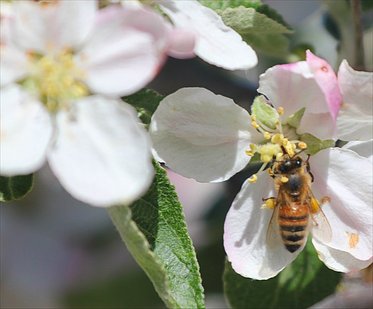 As I expect, the honey bees are present working over the flowers. The trees are so full of flowers, they don't have to search far.
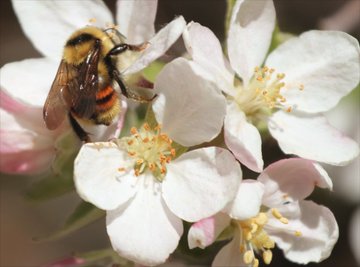 But there is competition! The apples are loaded with these guys, bumblebees. They have a much heavier throbbing buzz, often circling my head as they try to locate the flowers. Bumblebees are solitary and do not live in hives like the honey bees. They build nests instead, often in the ground.
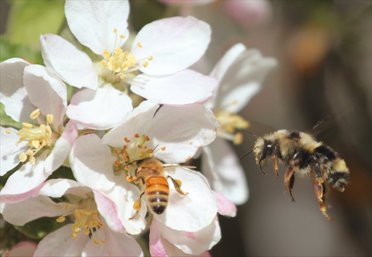 It is good to see them, even if they are competing. The number of species of bumblebees has been in decline in recent years. They are very good pollinators and work the flowers over vigorously. In fact, I have noticed that they have been hitting the apples more than the honey bees. I expected heavy coverage from my bees, but it was less than anticipated. Watching the hives, I noticed several bees heading out and flying south, opposite in direction of the apples. This seems strange, but they evidently have something more interesting elsewhere (I never figured out what). Once they are on to a flower source, they tend to concentrate on that, no matter what else is around them.
In the last couple of days the apples have slowed down in blooms, losing most of their petals. This evening, however, I found the bees flying into the hive with very heavy pollen loads. They were so heavy many were having trouble flying and getting into the entrance. They are very good at finding sources and have found another place to hit for now. All good signs.
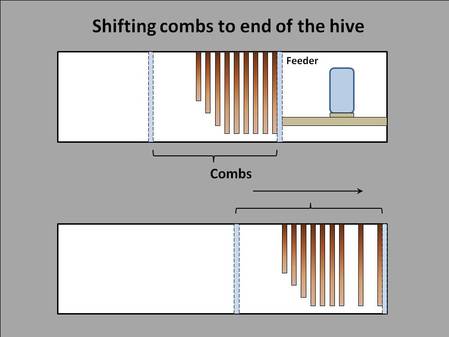 This weekend, I also did a bit of late spring maintenance, getting ready for summer and the fall-winter to follow. The bees were centered in the middle of the hive with the follower boards on each side. The syrup feeder was on one end (there is a hole in the follower board to give them access). As they are building more and more comb, they need room. I can keep moving the follower board on the left out, but may run out of space. They are also not using the feeder anymore so, I took that out and shifted all the combs down to the right. This gives us more room. They will, hopefully, start filling honey comb towards the open space on the left as I move the follower out. Shifting to the end also prevents them from making honey stores on both ends. That could be bad in the winter if they trap themselves on one end of the hive away from the remaining honey stores (the bees have limited movement when it is cold). In the fall, before winter sets in, I will harvest a few combs of honey from the left and recenter them in the hive. This will give them a bit of insulation and allow room for the feeder again over winter. I also want to be sure to leave plenty of honey comb for them to live off of during the winter. The feeder will be there, but honey is better for them. The winter here is long, though, and they'll probably need some feeding.
I also added a couple of empty bars to the right side, where the brood is. This is supposed to help keep them busy making brood, boosting hive numbers, and limiting the swarming potential. Somewhat of an experiment for now to see how they handle it.
So, we continue on. Until next time....
Spring is here. Waiting through the winter, spring is always so inspirational. Green grass, rain showers, and sunshine! The promise of lazy warm summer days ahead. Of course, then there is the reality..... Spring in northern Idaho hits fast and hard. Everything goes at once and it does so with rain. Long, day after day of gray, wet days. Then the grass is suddenly a foot long, weeds pop up every where and it's too wet to do anything :-) I've been eying the weather report for a week now. A short, blissful morning of sun has been forecast for Wednesday. I have been wanting to get into the hive for a while and now, my chance! I carved out a few hours from work this morning and recruited Kara to help. Great volunteer and photographer! Thank you Kara!
Oh, and just in case you're wondering, the sun didn't last ... we're now under a winter storm warning :-P .
.
.
.
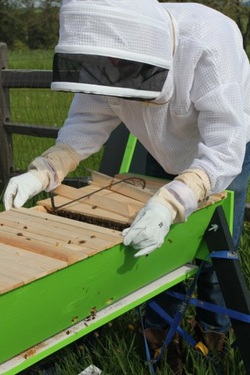 We started off by peeking in the window to see where the active comb building has stopped. Then I gingerly start prying out the bars. The bees do not like gaps in the hive and they plug them with propolis, a bee glue of sorts collected from tree resins. The bars are attached with this. I picked up a nice hand crafted tool for prying up the bars from Backyard Hives in Boulder. I try to work slowly, even though I am excited. The bees were very calm, more than one would expect seeing that their home is being broken open. A few guard bees angrily buzz out, but I simply stop and wait and they calm down.
I open only a little at a time, pulling out a bar, inspecting it, then replacing it sliding it towards me. This way I can move through the hive like a filing cabinet and also close it up quickly if the ladies get out of hand. They did not, however, so we continued.
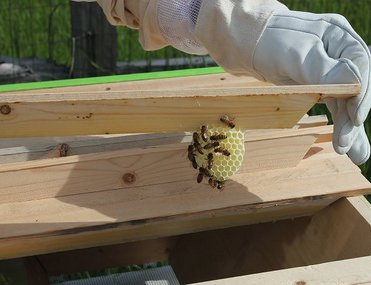 The first bar we check out has a small comb on it. This is new and was on the next bar over from the small comb I showed earlier. That comb is now much bigger, but not yet full size.
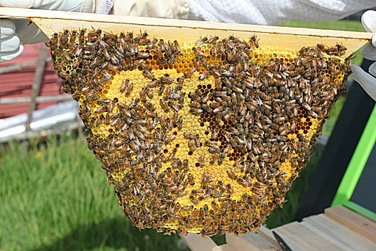 About three bars in we got to the first full sized comb. As you can see, the girls were busy here. The capped cells (lighter color) are worker brood pupae. Where the bees are is probably uncapped cells with larvae that they are feeding. Both sides of the comb looked similar to this.
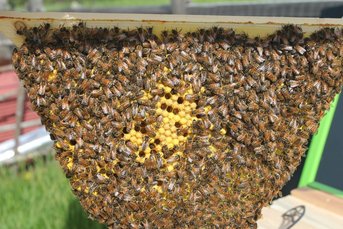 Further in, another full comb. This one has puffier capped cells that look like pencil erasers. These are drone cells for the males bees. These arise when the queen lays an unfertilized egg. It is normal to produce these and says they are planning ahead to when drones may be required.
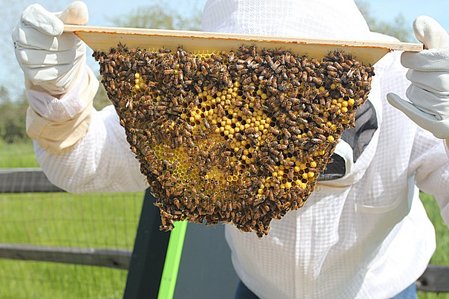 This is a mixed brood comb, with both worker and drone cells. There are several uncapped cells too. The combs serve many purposes, from rearing to storage to physical support.
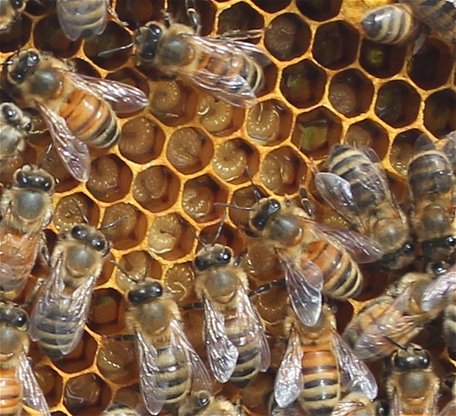 The little grub like critters in these uncapped cells are larvae, fairly well developed. They will eventually pupate and the workers will cover or cap their cells.
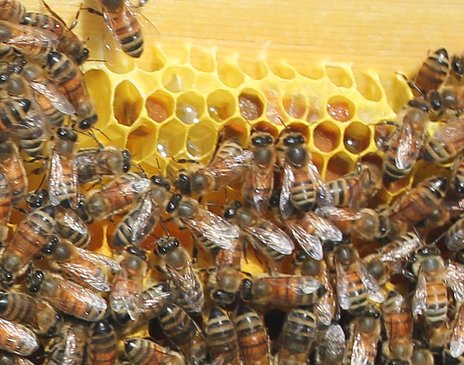 There were also some pollen storage cells, the peanut buttery stuff shown here. These were mostly towards the tops of the bars. I did not see a lot of nectar storage (eventual honey), but this is not unexpected given we haven't had a lot of flowering yet.
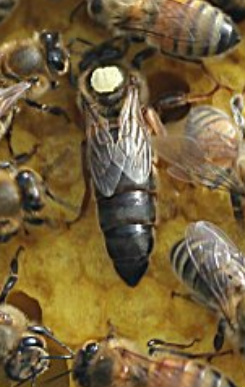 And then there was the queen. I was glad to find her (Kara actually saw her first). She is much larger and black. She was marked before the package shipped, which is the white dot on her back. This helps in spotting her in the mass of bees. She appeared to be healthy and, given the amount of brood present, she's been busy laying eggs!
All hail the Queen!
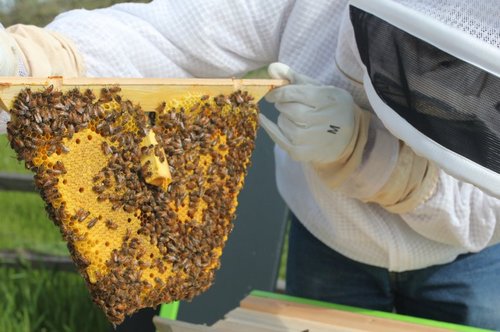 Finally, towards the beginning of the combs, we found the queen cage. I never got the chance to remove it and so they built around it. Not really a problem. Some advocate cutting it out, but I left it in. It should not cause any problems.
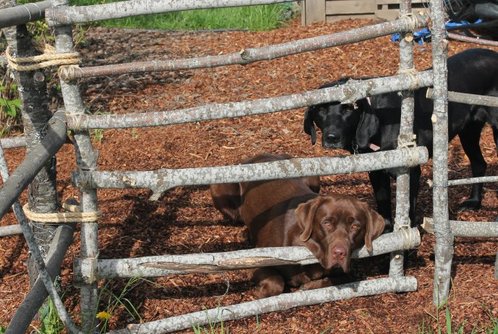 Oh, and there was a spectator gallery too. Griz and Meadow didn't want to be left out and really wanted in the bee yard. They were good though and just watched patiently.
Now we just continue watching. The apple trees are about to bust out in bloom and other flowering plants are ready to go too. This will probably be one of the last big winter storms we get, so I am hopeful the bees will have plenty to work on soon.
The other day, when I was spying on the hive through the window, I noticed how warm the cluster of bees was through the glass. Bees gather together to keep warm and actively heat the hive and brood comb when it is cool out (they cool it too when it is hot). They need to keep the temperature "just so" for the larvae and pupae to develop. This morning I went out to replace the feeder and took my infrared thermometer with me. I usually use this to monitor the wood burning oven, but it comes in handy elsewhere too :-)
 This was shooting the temp through the glass at the edge of the bee cluster, but there was quite a difference. The first measurement is on the other side of the follower board next to the feeder, where there were no bees. The second was on the bee cluster itself. It is probably hotter still deeper in the bee cluster, but even with this we can see how warm they get. The outside temperature was about 32*F at the time. The bees heat up by vibrating their flight muscles in the thorax (which is where most of that sugar is going!). I also noticed the other day that Christy at Gold Star Honeybees had linked to a great video on "heater bees" where researchers had actually used infrared cameras to capture the process. Check out the video. Bee-wise, not a lot of change here. We have had another bout of colder weather - down to freezing. This has limited the bees activity and I noticed they have started hitting the feeder again (gotta stay warm). Today should be warmer and sunny so they should be getting out. As for the temperature, the bees should be able to handle it, but I am anxious about the trees (plum, apple and pear) as they are just about to break out in bloom. It is not unusual to have the crop freeze out at blossom and I'd really like to have those available for the Apis clan.
A nice picture here of the little comb that was there earlier. It has grown quite a bit to about 5 inches across. They will continue expanding this heart shaped wax fin until it fills a cross section of the hive.
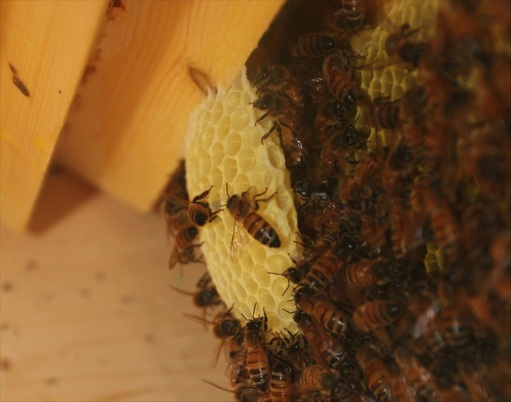 They "know" just how to do this without any directions! Young bees produce wax between the segments on their abdomens which they mold using their mandibles to shape into comb. A long process that takes many bees a short time.
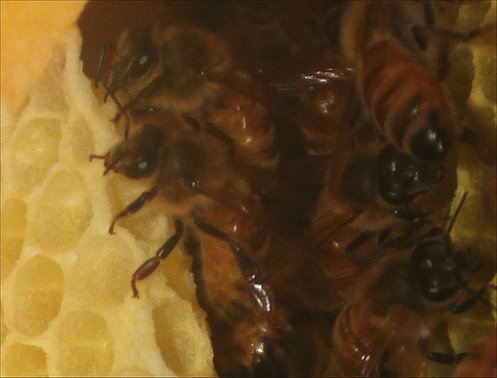
I've also noticed that the last jar of syrup I fed them is only half eaten. I'm hoping that is a sign that they've had their fill of sugar and are getting enough nectar naturally.
|













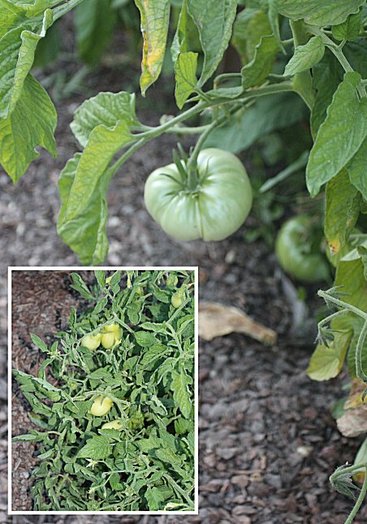
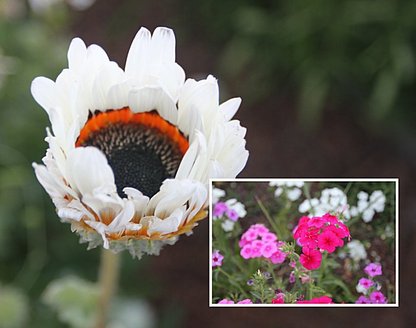


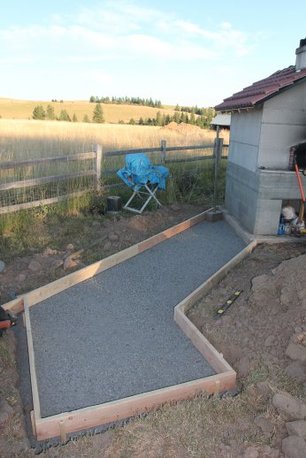








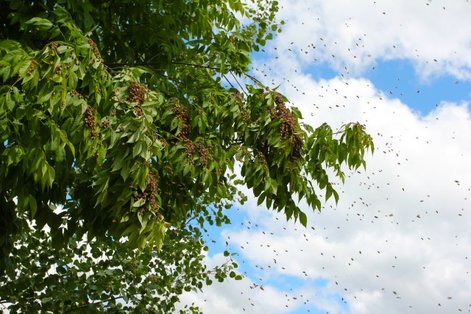
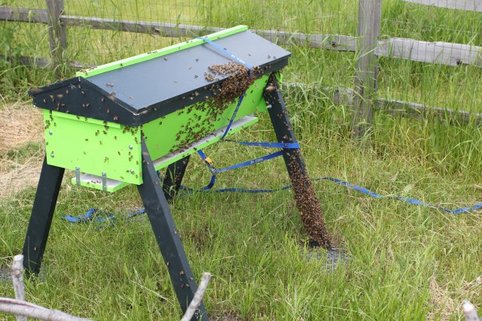
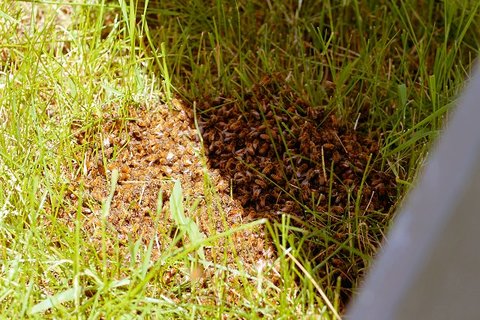
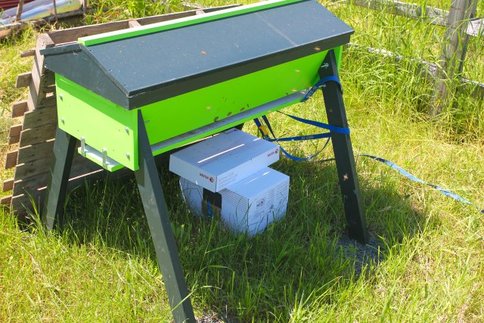
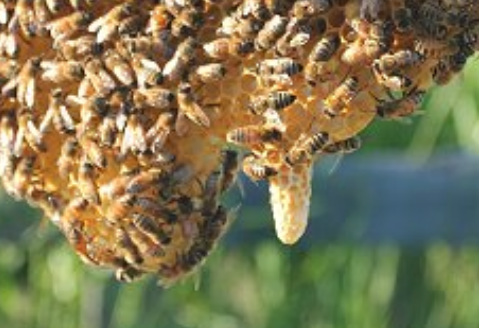
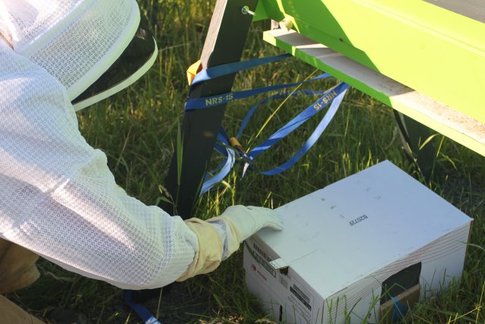
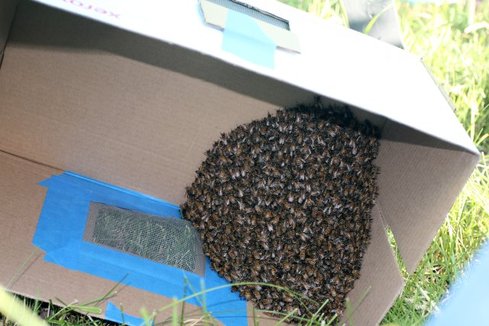
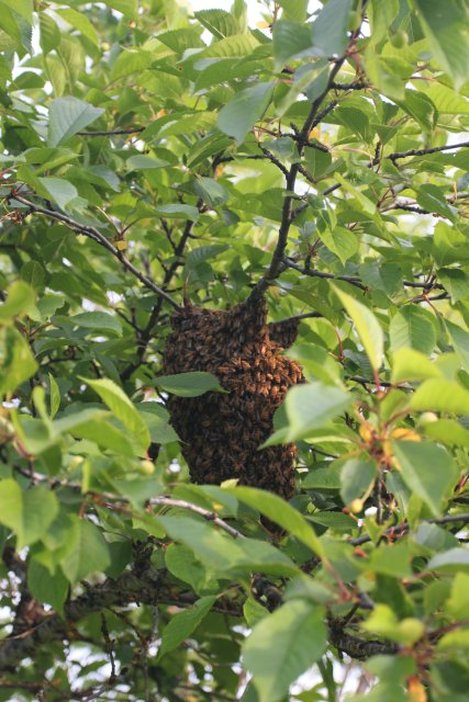
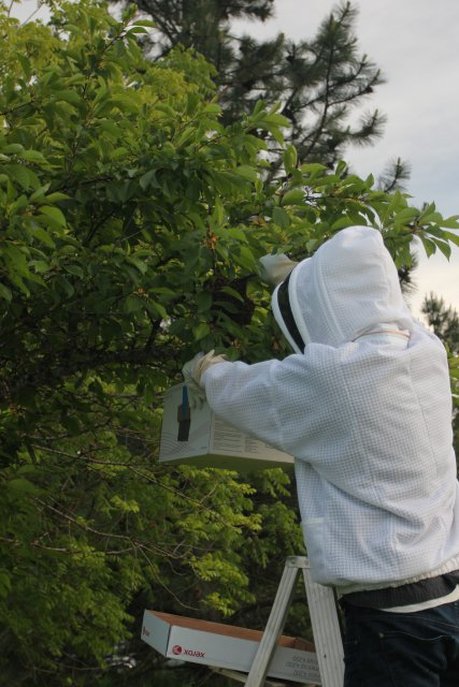
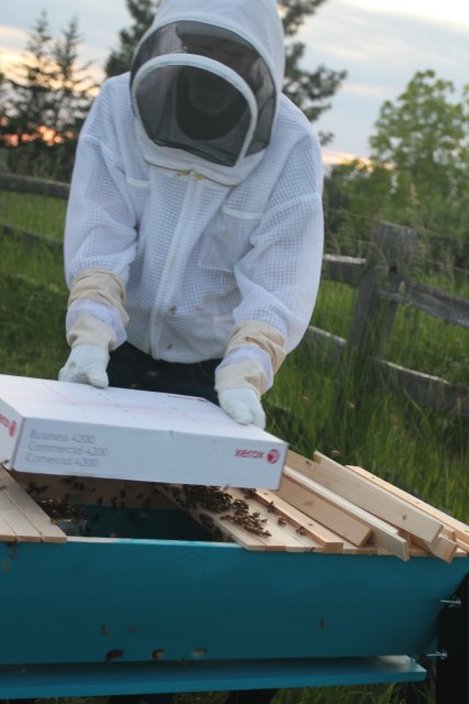
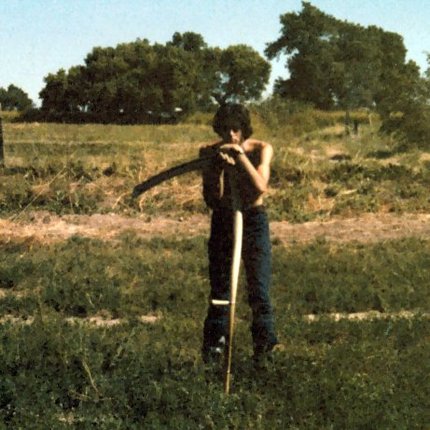


















 RSS Feed
RSS Feed